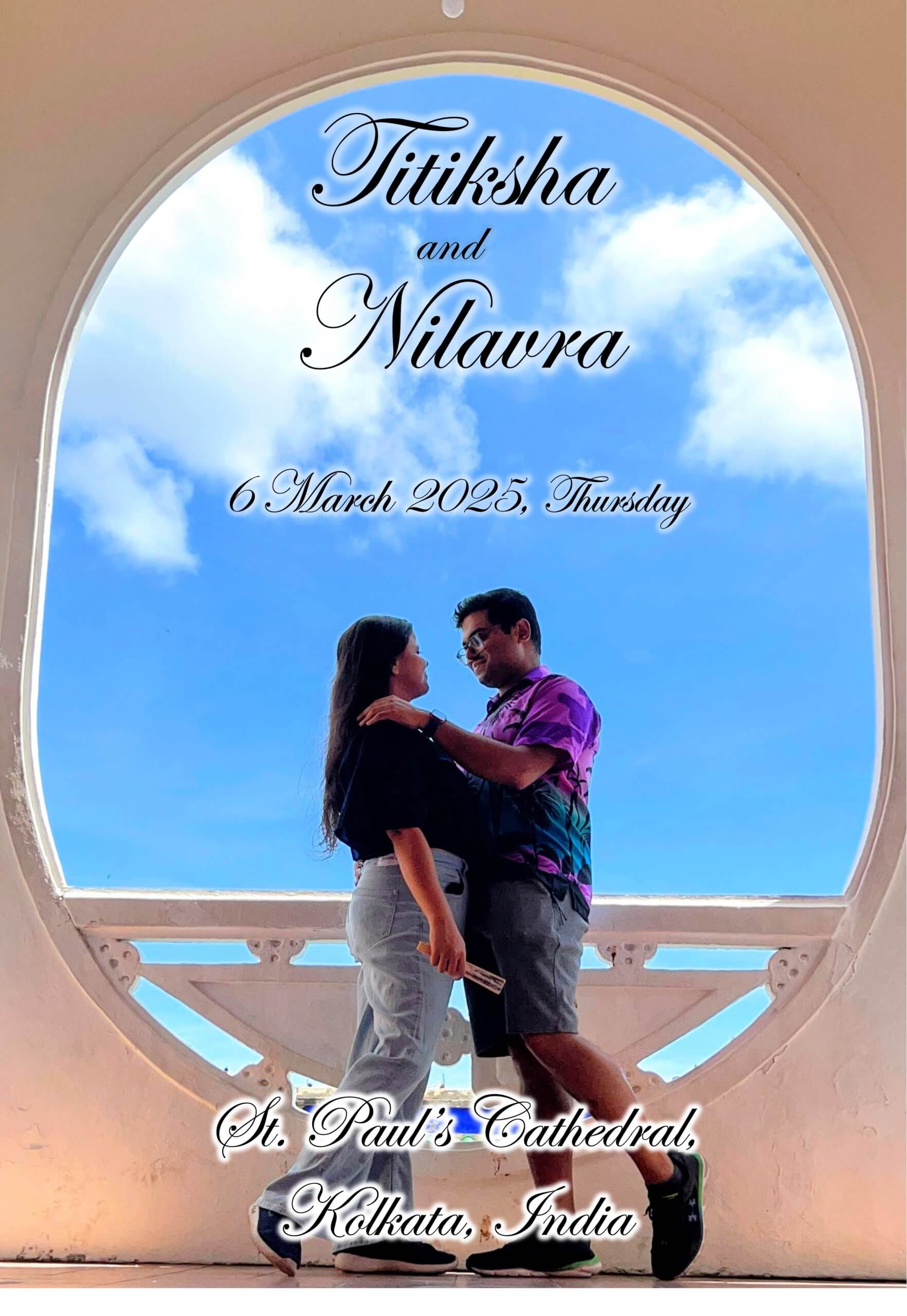
Dr. Nihar Ranjan Bhattacharya and
Dr. (Mrs.) Ratna Bhattacharya
cordially request the pleasure of your presence and blessings
on the auspicious occasion of
The Wedding Reception Ceremony
of our only son
Nilavra
with
Titiksha
Younger daughter of Late Mr. Tapas Sarkar
and Mrs. Tapati Sarkar
To be held on:
March 6th, 2025, Thursday
6:30 pm onwards
We are looking forward to seeing you! Here are some more information which may be useful while planning your travel.
About The Venue
St. Paul’s Cathedral, said to be the first Anglican cathedral in Asia, is noted for its “Indo-Gothic” architecture, and dedicated to Paul the Apostle. It is the seat of the Diocese of Calcutta. The cornerstone was laid in 1839, during the growing population of the European community in Calcutta in the 1800s. The building was completed in 1847.
Nearest Airport: CCU Kolkata
The reception venue is located 21 km from Kolkata airport (CCU, standing for Kolkata’s former Anglican name: Calcutta), and takes between 30 – 60 mins to reach depending on city traffic conditions.
If you need help with travel reservations or other options, please get in touch with us and we will be happy to help.
Travel from Outside India
The best way to reach Kolkata from outside India is via a connection either within India (Delhi or Mumbai), or in the Middle East (Dubai, Doha, or Abu Dhabi).
Possible routes can be:
Europe / USA
–> Dubai DXB / Doha DOH / Abu Dhabi AUH / Delhi DEL / Mumbai BOM
–> Kolkata CCU
e-Tourist Visa for India
If you are not an Indian national, you may need to apply for an e-Tourist Visa. Details can be found below:
Rituals at a Bengali Wedding
Aiburobhaat: A Traditional Bachelor(ette) Party (Mar 2)
Just like a bachelor or bachelorette party, Aiburobhaat is a delicious treat given to the bride and groom by their family, friends and close relatives. This traditional custom marks the beginning of a grand celebration.
Bibaho / Biye: The Wedding (Mar 3)
The main “wedding” event wherein the groom’s procession journeys to the bride’s house (aka the wedding venue) to undertake the wedding rituals. The event is hosted by the bride’s family, and the Biabho (wedding) comprises multiple rituals during the course of the evening. A gala dinner takes place in parallel.
After the wedding ceremony is concluded, the groom takes the bride and travel’s back to his house.
Bodhu Boron: Welcoming the Bride (Mar 4)
When the new bride arrives at the door-steps of his husband’s house, her mother-in-law welcomes her into the house and family. This ritual symbolizes the entry of goddess Lakshmi into the house.
Phool Sojya: The Bed of Flowers (Mar 5)
The family members of the groom take the responsibility to decorate a beautiful floral bed after which the newlyweds begins their new life.
Bou Bhaat: The Reception (Mar 5 and 6)
The last wedding ritual is called Bou Bhaat where the groom’s family throws a big reception party by inviting their friends, relatives, and the bride’s family. After this wedding ritual both the couple unites for a lifetime. We have split our Bou Bhaat ceremony into two parts: a smaller pre-Reception dinner at the groom’s house on Mar 5, and the bigger Gala Dinner event on Mar 6 at St. Paul’s Cathedral, Kolkata.
If you would like to know more about Bengali marriage ceremonies and rituals, the webpages below have beautiful illustrations.
Tips and Recommendations for Visiting Different Parts of India
Late February and early March is a great time to visit India. If you would like to know more about possible places to go, we have prepared a guide for you. If the guide below is not displayed, please click here (Google Slides).